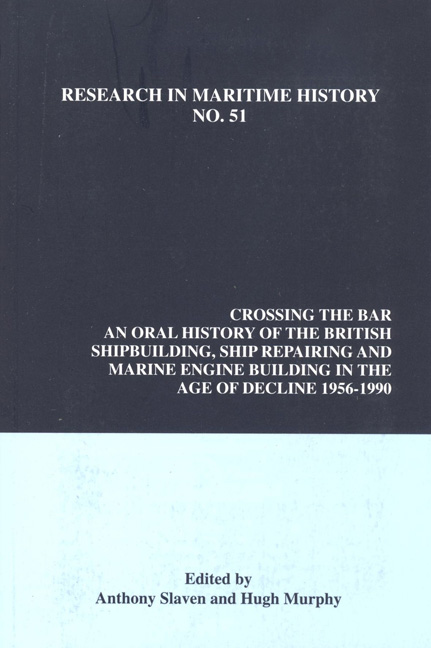 Crossing the Bar
Crossing the Bar Book contents
- Frontmatter
- Contents
- About the Authors
- Dedication
- Preface: A Shipbuilding Libretto
- Introduction
- Interviews
- Lower Clyde
- Upper Clyde
- 4 Sir Eric Yarrow, Weir Engineering, Cathcart, Yarrow Shipbuilders
- 5 Dr. Brian Baxter, Yarrow Shipbuilders
- 6 Bob Easton, Yarrow Shipbuilders
- 7 Sandy Stephen, Alexander Stephen Shipbuilders and Engineers
- 8 Professor John Rorke, Alexander Stephen, Denny Brothers, Brown Brothers
- 9 Fred Walker, Denny Brothers, Fairfield, Connell and Hall Russell
- 10 Jolyon Slogett, Denny Brothers, Houlder Bros., British Shipbuilders Plc
- 11 Dr. John Brown, John Brown, Clydebank
- 12 Graham Strachan, Alexander Stephen, John Brown and Scott Lithgow
- 13 J.F. Starks, John Brown, Upper Clyde Shipbuilders
- 14 Anthony Hepper, Upper Clyde Shipbuilders
- 15 Harry Osborne, Civil Engineer
- The Tyne
- The Wear
- Barrow-in-Furness
- The South Coast
- The Humber
- Belfast
- British Shipbuilding Industry Officials
- The Trade Unions
- The Civil Servants, Board of Trade, Shipbuilding Enquiry Committee, Shipbuilding Industry Board, Ministry of Technology, Department of Trade and Industry, Department of Industry
- The Politicians
- Interviews British Shipbuilders Plc
- Conclusion
- Select Bibliography
5 - Dr. Brian Baxter, Yarrow Shipbuilders
from Upper Clyde
- Frontmatter
- Contents
- About the Authors
- Dedication
- Preface: A Shipbuilding Libretto
- Introduction
- Interviews
- Lower Clyde
- Upper Clyde
- 4 Sir Eric Yarrow, Weir Engineering, Cathcart, Yarrow Shipbuilders
- 5 Dr. Brian Baxter, Yarrow Shipbuilders
- 6 Bob Easton, Yarrow Shipbuilders
- 7 Sandy Stephen, Alexander Stephen Shipbuilders and Engineers
- 8 Professor John Rorke, Alexander Stephen, Denny Brothers, Brown Brothers
- 9 Fred Walker, Denny Brothers, Fairfield, Connell and Hall Russell
- 10 Jolyon Slogett, Denny Brothers, Houlder Bros., British Shipbuilders Plc
- 11 Dr. John Brown, John Brown, Clydebank
- 12 Graham Strachan, Alexander Stephen, John Brown and Scott Lithgow
- 13 J.F. Starks, John Brown, Upper Clyde Shipbuilders
- 14 Anthony Hepper, Upper Clyde Shipbuilders
- 15 Harry Osborne, Civil Engineer
- The Tyne
- The Wear
- Barrow-in-Furness
- The South Coast
- The Humber
- Belfast
- British Shipbuilding Industry Officials
- The Trade Unions
- The Civil Servants, Board of Trade, Shipbuilding Enquiry Committee, Shipbuilding Industry Board, Ministry of Technology, Department of Trade and Industry, Department of Industry
- The Politicians
- Interviews British Shipbuilders Plc
- Conclusion
- Select Bibliography
Summary
I started as an apprentice in the Royal Dockyard at Sheerness, Kent, and was sent to the Dockyard at Hong Kong. I joined up there, but when the Japanese captured it, I became a prisoner of war for four years. At the end of the war I returned to Britain and became a student of naval architecture at Newcastle University. On graduating, I joined the Royal Naval Scientific Service and served at Rosyth. I subsequently left Rosyth to take up a lecturing position at Newcastle and taught there from 1950-1957. I then became the chief representative of the French classification society, Bureau Veritas for five years. In 1962 I joined Yarrow as Shipbuilding Director, and stayed there until 1982. From 1980 to the present, I have been the Visiting Professor in Naval Architecture at the University of Strathclyde.
When I started at Yarrow in 1962 everybody was our competitor, because there were ten yards at least in Britain who were building warships: John Brown, Stephen, Denny, Scott's, Fairfield, Swan Hunter, Cammell Laird, Harland and Wolff [all mixed naval and mercantile yards] and others. All were building Leander class frigates, so it could be said that we were in competition with all of them. Yarrow believed and said, “none of you are as really dedicated as we are. ” The possible exceptions to this were Vosper Thornycroft [onthe south coast of England] and Denny [at Dumbarton] who went out of business in 1963. They had the same sort of feeling about the Royal Navy that we did, and in many ways they were similar firms. They were all strong family firms formed by strong characters, namely, Sir John Thornycroft [on theThames], Sir William Denny, and Sir Alfred Yarrow [on the Thames], and they all restricted themselves to the same sort of small warships. We were not like John Brown, Stephen or Fairfield. We were going to build small warships, and that is what we told the Admiralty [the department of state responsible forwarship construction and repair in the UK up to 1964]. We not only did that, but we also made a point of asking, what's the size of the largest frigate you are going to order over the next decade? We deliberately built our covered berth and our fitting-out basin to accommodate that size.
- Type
- Chapter
- Information
- Crossing the BarAn Oral History of the British Shipbuilding, Ship Repairing and Marine Engine-Building Industries in the Age of Decline, 1956-1990, pp. 21 - 26Publisher: Liverpool University PressPrint publication year: 2013


